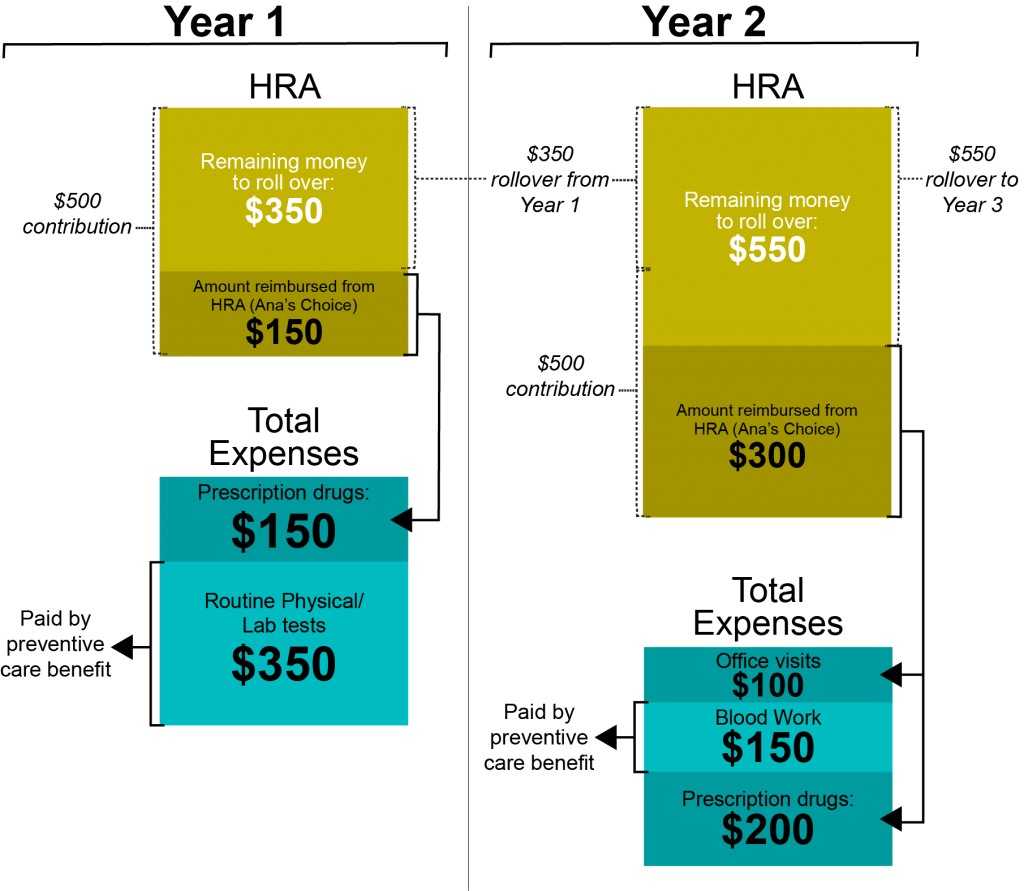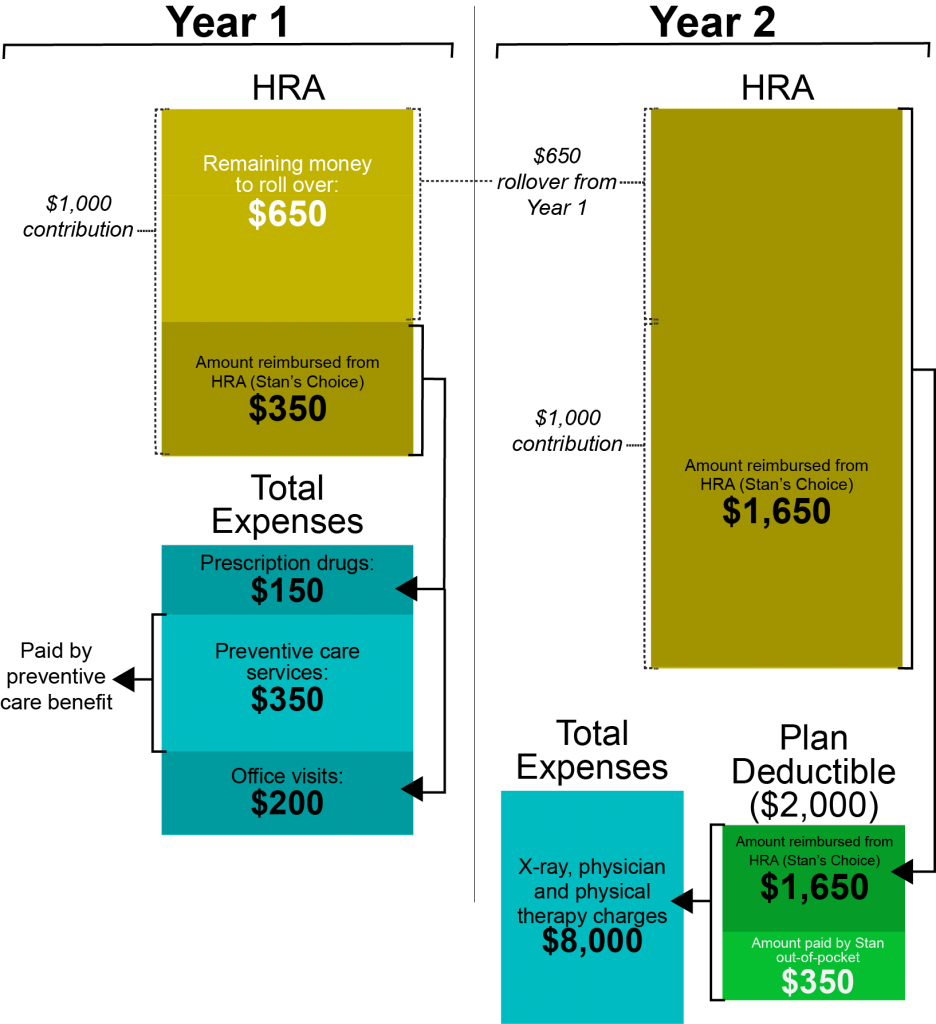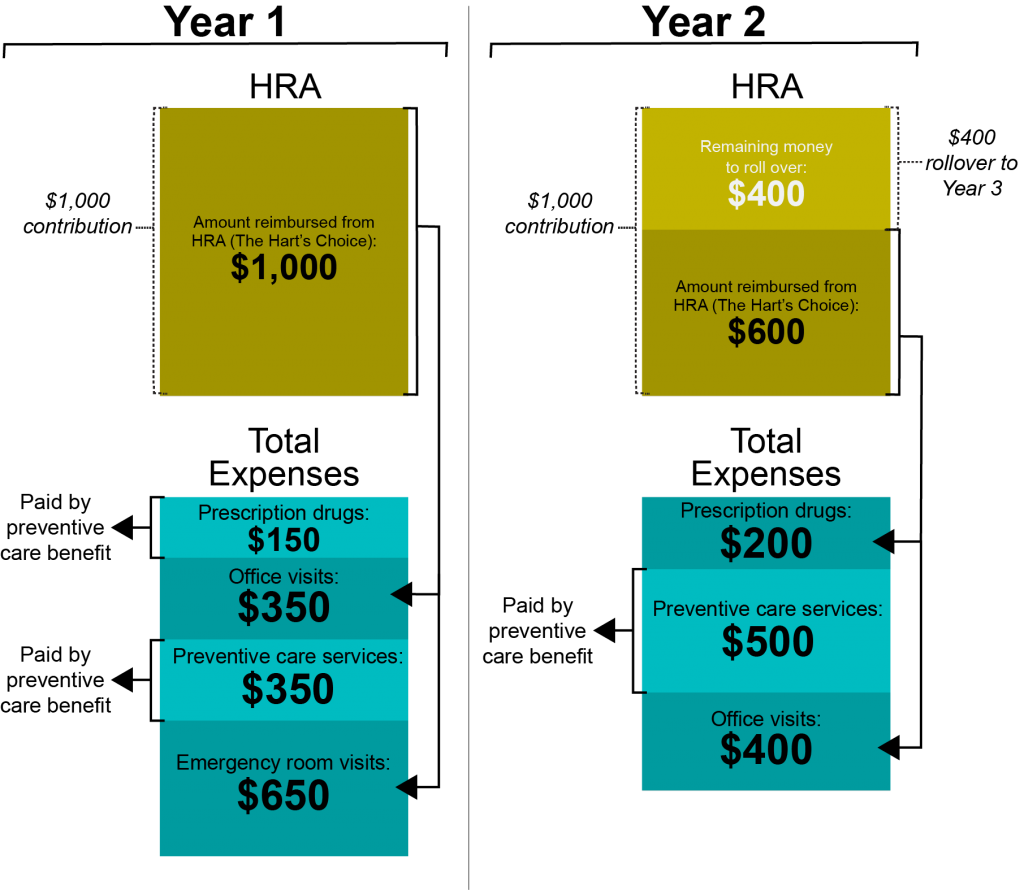Choosing the right health coverage plan can be difficult, but a health reimbursement arrangement (HRA) can be a great way to take advantage of employer contributions for your health care expenses.
What Are HRAs?
HRAs are employer-funded arrangements that reimburse employees for certain medical expenses. Generally, an employer can only offer an HRA to employees with a group health plan, often a high deductible health plan (HDHP). Your employer determines the amount of money available in the HRA, which is typically an amount less than your annual health plan deductible.
One of the reasons why HRAs were created was to help employees be more aware of their health care expenses while helping them meet their deductibles with tax-free health funds. The Internal Revenue Service (IRS) provided an official definition of HRAs in 2002, and HRAs underwent other regulatory changes with the Affordable Care Act (ACA), which now generally prohibits standalone HRAs that are not integrated with an ACA-compliant group health plan.
HRAs can be a great way to pay for out-of-pocket health care expenses while still working down your deductible, especially if you have an HDHP.
Why Have an HRA?
HRAs provide a tax-free, employer-funded amount of money for health care expenses. These arrangements are a great way to pay for out-of-pocket qualified medical expenses while working to meet your plan deductible.
HRA Advantages
If your employer offers an HRA, it can be a tremendous advantage as you pay out-of-pocket medical expenses, especially with an HDHP. HRAs offer several benefits:
Tax Savings
• Your employer’s contributions to your HRA can be excluded from your gross income, meaning you don’t pay taxes on that money.
• Reimbursements from your HRA are tax-free when used to pay for qualified medical expenses (which are the only expenses they can be used for).
Out-of-pocket Expense Reduction
• Often paired with an HDHP, reimbursement from your HRA will make it much easier to meet your deductible while taking advantage of a health plan with lower premiums.
Accrued Balance
• Depending on your employer’s plan, unused amounts in the HRA may be carried forward for reimbursements in later years.
Is an HRA Right for You?
An HRA can prove to be advantageous for employees who don’t want to reduce their salary through a salary deferral to fund an account, such as with health savings accounts (HSAs) and health flexible spending accounts (FSAs). An HRA is entirely employer-funded, essentially boosting your salary with tax-free money for health care expenses.
An HRA, however, gives you less flexibility than an HSA or FSA—with those accounts, you can choose how much you want to contribute to the account instead of your employer determining the amount available in the fund. Although you can’t choose how much money will be contributed to an HRA for you, HRAs are still a great way to reduce your out-of-pocket health expenses.
How Do HRAs Work?
HRAs are funded by your employer, and, in most cases, must be paired with another group health plan. When you incur qualified medical expenses, you can then be reimbursed for those out-of-pocket costs from your HRA.
HRA Eligibility
You may be eligible for an HRA if your employer sponsors an HRA and you meet any eligibility requirements established by your employer. Effective for plan years beginning on or after Jan. 1, 2014, an HRA typically must be offered with other health plan coverage, such as HDHP coverage, to satisfy certain requirements under the ACA. You may be required to be enrolled in other group health plan coverage in order to participate in the HRA. If you have questions about your HRA eligibility, you should talk to your manager or [C¬_Officialname]’s human resources.
Self-employed individuals are not eligible for an HRA. Certain limitations may apply if you are considered a highly compensated individual at your organization.
Contributions
HRAs are funded completely by employer contributions. These employer contributions are generally excluded from your gross income, essentially making it tax-free money. Different from HSAs or health FSAs, employees cannot make contributions to an HRA. Most employers with HRAs create notional, or unfunded, accounts for each participating employee and reimburse eligible medical expenses up to each employee’s HRA balance.
Each employer has considerable design flexibility with respect to their HRAs. Your employer will set the maximum reimbursement amount under the HRA, which may vary for different groups of employees. For example, an employer may decide to have one maximum limit for employees with self-only health plan coverage, and another maximum limit for employees with family health plan coverage. However, employers are generally prohibited from basing contributions on an employee’s age, length of service or compensation.
The contribution amount is typically less than your deductible. However, the employer may choose to allow a rollover, which means unused funds from your HRA can be carried over and used in subsequent years.
Using Your HRA
You can use your HRA funds to get reimbursed for your own eligible medical expenses, as well as your spouse’s and dependents’ eligible medical expenses. Eligible medical expenses are unreimbursed medical care expenses, as defined under Section 213(d) of the Internal Revenue Code. An employer can more narrowly define the expenses that can be reimbursed from its HRA. Your HRA coverage must be in effect at the time the qualified medical expense is incurred in order to receive reimbursement. When you are paying for a qualified medical expense that you would like to use your HRA funds for, you typically have two choices: using a health payment card or requesting reimbursement.
Health Payment Card
Some employers may provide you with a health care payment card, which is very similar to a debit or credit card, and you can pay for eligible medical services or products by swiping the card as you would a debit or credit card. The money will then be deducted from your HRA account. Health care payment cards may be used only on eligible medical expenses that are not reimbursed or covered by another source. Over-the-counter (OTC) medications are only eligible for reimbursement if they are prescribed to you and if you present the prescription at the time of purchase. The only OTC medication that can be reimbursed without a prescription is insulin. Health care payment cards may not be used to cover more than the maximum dollar amount of coverage available in your HRA.
Reimbursement
Another way to pay for eligible medical expenses with your HRA funds is to pay out-of-pocket and then submit receipts for reimbursement. Your account will have specific instructions for how to do this. When submitting for reimbursement, you will need your receipts and proof that what you paid for was an eligible expense; this is one of the reasons it is important to keep all receipts and related paperwork from your health care provider.
Qualified Expenses
You may use your HRA to pay for qualified medical expenses incurred by you or your spouse and dependents, as long as the expense is not reimbursed from another source, such as other group health coverage. In addition, expenses cannot be reimbursed through an HRA if you are taking a tax deduction for those expenses. HRA funds may not be used to pay for individual insurance policy premiums. Qualified medical expenses are those specified in the plan that would generally qualify for the medical and dental expenses deduction. Examples include amounts paid for doctors’ fees, prescription medicines and necessary hospital services not paid for by insurance. You can use your HRA funds for deductibles, copayments and coinsurance. See the Appendix for more examples of qualified medical expenses. Your employer may cover all qualified medical expenses, or it may choose to limit what the HRA will cover to a more exclusive list.
Life Events
Certain life events will trigger changes in eligibility for an HRA. If you terminate employment, die or drop your group health plan, you may no longer be eligible for an HRA. You can, however, be reimbursed for any medical care expenses incurred prior to the termination date of your HRA, up to your account balance in the HRA. An unused HRA balance cannot be cashed out. If you are eligible for and elect COBRA coverage, your HRA may continue; check your plan summary for details.
HRA Recordkeeping
In many cases, you will have to submit receipts and proof that you purchased an eligible medical service or product in order to receive reimbursement. Make sure you retain all receipts, Explanation of Benefits (EOBs) and other documents to ensure that you have the necessary proof to obtain reimbursement from your HRA.
Case Studies and Examples
Following are three case studies that demonstrate how an HRA can benefit you in various life stages and circumstances.
Case Study – Single Person with Low Medical Expenses
Ana is a healthy 26-year-old single woman who is physically active and financially stable. Her employer contributes $500 each year to her HRA, and her employer’s HRA permits rollover of unused funds from one year to the next. Her plan’s annual deductible is $1,500 for individual coverage. If Ana uses her HRA to pay for covered services, this will reduce the out-of-pocket amount needed to meet her deductible before traditional health coverage begins.
Here is a look at the first two years of Ana’s HRA plan:
Since Ana did not spend all her HRA dollars, she did not need to pay any additional amounts out-of-pocket for her medical expenses in either year.
Case Study – Single Person with Medical Expenses
Stan is divorced and in fairly good health at age 52, but he had to have surgery on a bad knee. His employer has allocated $1,000 to his HRA for each year, and his employer’s HRA permits rollover of unused funds from one year to the next. When Stan had surgery, he incurred X-ray, physician and therapy charges totaling $8,000. Stan’s plan has an individual deductible of $2,000. If he chooses to use his HRA to pay for covered services, this will reduce or eliminate the out-of-pocket amount needed to meet his deductible before traditional health coverage begins.
Here is a look at the first two years of Stan’s HRA plan:
Case Study – Family with Unplanned Expenses
The Hart family had some unexpected medical costs this year—wife Sheryl found out she was pregnant, daughter Tara was hospitalized for pneumonia and son Cory needed stitches. Husband John’s employer contributes $1,000 to their HRA each year, and their plan’s annual deductible is $5,000 for family coverage. His employer’s HRA permits rollover of unused funds from one year to the next. If they choose to use their HRA to pay for covered services, it will reduce the out-of-pocket amount needed to meet their deductible before traditional health coverage begins.